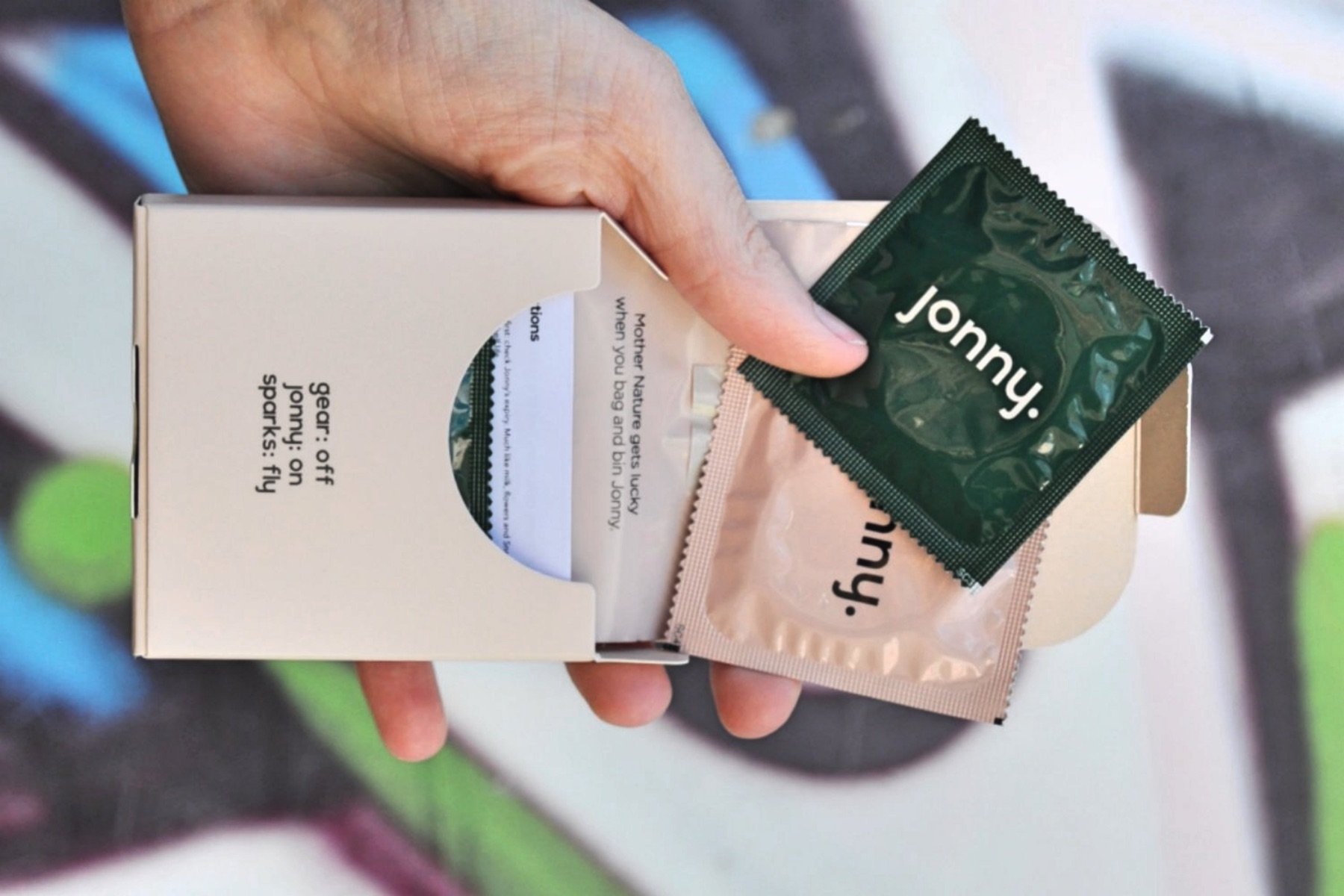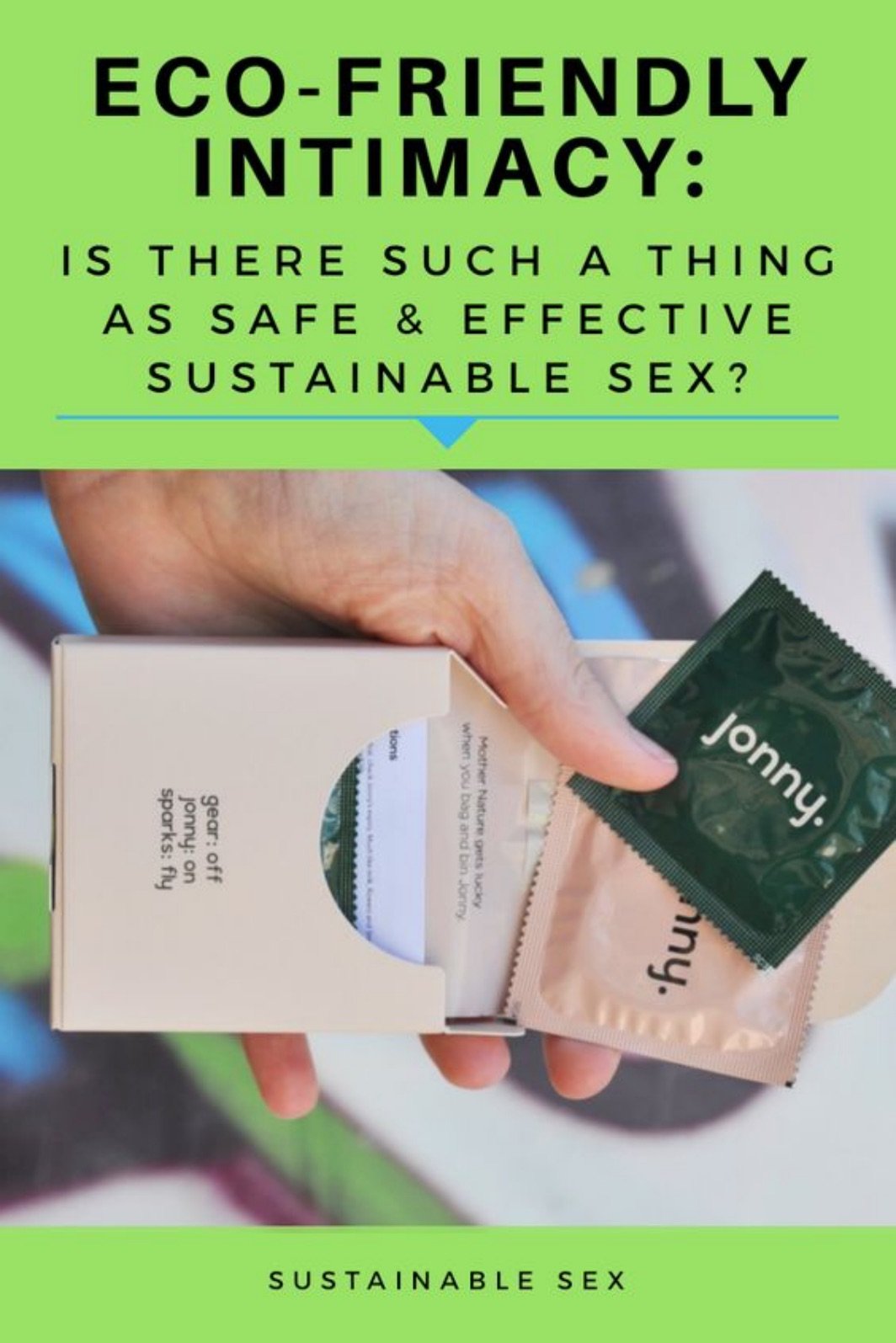Eco Intimacy: What Does Safe Sustainable Sex Look Like?
How can sex be practiced safely and sustainably? We look into eco-friendly contraception and arousal - finding out what the options are and if they are safe and effective as family planning is an important part of sustainability.
In itself safe sex is sustainable as family planning affects greenhouse gas emissions. The Drawdown project compared how much energy, building space, food, waste, and transportation would be used in a world where there was increased adoption of reproductive healthcare and family planning with one with little to no investment in family planning and found that “the resulting emissions reductions could be 102.96 gigatons of carbon dioxide”.
Less people on the planet equals less strain on the planet. So any form of contraception is better than no contraception.
This does not mean we are hating on any eco-mums in any way. We believe it is important that there are environmentally aware parents out there who are bringing up their children to love and care for the earth. We’re going to need them!
And no one who really wants children should be shamed into not having children. But we do agree with limiting population growth and not bringing extra people into this world unwittingly.
So, are there contraceptive products that are more eco-friendly or that will result in less waste going to landfill that are actually effective? We researched how to have environmentally responsible sex and lay out the options below.
***very importantly, we are not experts in this field in any shape or form so please don’t just rely on our research. Even though we do ensure our articles are as thorough and accurate as possible, always get a medical professional’s opinion before making a decision that may affect your body, health, and welllbeing. This article is aimed at discussing the sustainability of contraception options and our opinions and research thereof.
1. Eco-friendly, additive-free condoms
Regular condoms are generally made from synthetic latex (petroleum based) or other synthetic materials such as polyisoprene, polyurethane (non-latex condoms), or AT-10 resin. These synthetic, plastic-containing condoms won’t ever biodegrade.
The additives that regular condoms can contain include (source):
nonoxynol-9, a spermicidal detergent that if frequently used of “can cause inflammation of the cervix, vagina, and rectum, undermining their cellular integrity and increasing the permeability of delicate mucosal tissues”,
parabens, a preservative that potentially increases the potential for certain types of cancer - although the evidence is inconclusive and this is still debated,
glycerin, another preservative that could increase STI risk by promoting the growth of yeast infections, and
benzocaine, a topical anaesthetic that may cause “localised inflammation, irritation, and dryness … has the potential, albeit rare, of causing dizziness, rapid heartbeat, and breathing difficulty”.
In addition, most typical condoms contain casein, an animal by-product derived from goats/cow milk, so they are not vegan or cruelty free. You can get vegan condoms, which use a vegetable binder instead of casein.
A more eco-friendly option is condoms that are made from natural rubber latex, which comes from rubber plants. Natural latex is biodegradable and these condoms can actually be composted but they would take a lot longer to degrade than everything else in a home compost system as they would biodegrade at a much slower rate than other substances and it is uncertain if natural latex condoms containing stabilisers, preservatives, and hardening agents will decompose. So, it is best to send these to landfill unless explicitly stated by the maker that this is fine to compost them.
This should go without saying, but condoms - and anything else that is not toilet paper or a bodily function - should not be flushed down the toilet.
When using natural rubber latex condoms, it is important to remember that you should only use them together with water-based/non-oil based lubricants.
Another option is lambskin condoms, which are the earliest form of condom and are thought to have been used in early Roman Empire times. They are definitely not vegan as are made from the intestinal membrane of a lamb, but they are entirely biodegradable and can technically be composted, but again would take a long time in a home compost. They are also a good choice for those allergic to latex as they are latex-free. They are approved by the FDA as an effective means of contraception and are just as effective as other types of condoms, but they do not prevent STDs as they have pores that are too small for sperm to get through, but large enough for bacteria and viruses to pass through.
Examples of eco-friendly condoms are:
Jonny Vegan Latex Condoms (AU) (other countries here) - our personal favourite and what we use - which are free from animal derivatives, palm oil, casein, parabens, glycerin, petrochemicals, flavours, fragrances, benzocaine, and spermicides. They are dusted with corn flour and lubricated with silicone oil. They biodegrade over time and come with a discreet disposal bag, which is partly made from sustainable materials and is 100% biodegradable, completely degrading in landfill in 12 months. They have been rigorously tested and they comply with all Australian and international standards to ensure maximum safety.
FAIR SQUARED Condoms (UK) - vegan condoms made from fair traded natural rubber latex which are guaranteed and certified with a CE mark and tested to International standard ISO 4074.
Glyde Vegan Condoms (AU), which are made from natural rubber latex and are certified vegan as they contain no animal by-products. They are free of chemicals of concern often used for fragrance and spermicide, do not contain parabens or glycerin, and the rubber plantation used has sustainable growing and harvesting practices.
Kimono MicroThin Condoms (US/CAN), which are made from natural latex, are vegan and contain no Nonoxynol-9. Only one of the brands’ condom types, namely Kimono MicroThin Plus with Aqua Lube water-based lubricant, contains glycerin and parabens.
Naturalamb Luxury Condoms (AU/US/CAN), which are latex-free condoms made from lambskin.
Remember, although condoms offer reliable protection against pregnancy and STIs, they are not 100% effective against pregnancy, HIV/AIDS and/or infectious diseases. They are described as moderately effective by Nemours, with 18 out of 100 couples using this method getting pregnant in a year.
2. Rhythm method/fertility awareness
Pregnancy can be prevented by not having sex around the time of ovulation, so by knowing when and keeping note of when you are ovulating and abstaining at that time, you can reduce the chance of getting pregnant. The rhythm method or fertility awareness requires a commitment to monitoring body changes, keeping daily records, and not having sex during the fertile period.
This method is obviously the most zero waste and you don’t need to worry about using something your body isn’t keen on; however, fertility awareness is rated as less effective by this source, which notes that 24 out of 100 couples using this method get pregnant in a year. In addition, it doesn’t protect against STDs. So, it is a risky option on its own.
It can be hard to determine when you are ovulating as menstrual cycles can vary depending on the month, stress levels, changes in routine, illness, and other factors. If you are interested in learning more about the rhythm method and a few different methods of fertility awareness, go here.
A similar option is withdrawal or pulling out, which is also rated as less effective, also doesn’t protect against STDs, and 27 out of 100 couples using this method get pregnant in a year.
3. Spermicide
Spermicide is rated as less effective by Nemours, with 29 out of 100 couples using this method getting pregnant in a year, and it doesn’t protect against STDs. It should be used with another barrier method of birth control.
Nonoxynol-9 (N-9) is the most common active ingredient in spermicide and, as mentioned above, N-9 can irritate the vagina and appears to increase HIV transmission in high-risk women, perhaps by causing lesions and ulcerations in the genital mucosa, according to a study by the WHO.
If you’re looking for a more environmentally friendly spermicide, ContraGel Green Gel (US/CAN) is a CE 0124 Certified and Health Canada-approved natural, vegan, and chemical-free spermicide alternative that is hormone free and does not contain Nonoxynol 9. It comes in a recyclable box and metal tube.
4. Intrauterine Devices (IUDs)
IUDs save packaging waste because the repeated single-use packaging of other solutions such as condoms and the pill isn’t created as they are inserted once and remain in place for several years. In addition, they are said to be the most effective at preventing pregnancy.
An IUD is either a copper IUD or a hormonal IUD. According to this chart, they are very effective, with fewer than 1 out of 100 couples using this method getting pregnant in a year. However, they do not protect against STDs and there are some potential side effects.
If you want to learn more about IUDs and their advantages and disadvantages from a medical perspective, go here.
5. Birth control pill, patch, or shot
While the birth control pill comes with pill packet packaging, which is not recyclable in some areas but is in some areas, the waste caused by the patch is the packaging it comes in and the patch itself, and that of the shot includes the syringe, needle and their packaging.
There are worries about female hormones ending up in water supplies via the urine of those taking contraceptive pill being flushed down the toilet. This study found that “drinking water treatment processes effectively reduced estrogenicity” and “all samples were below estimated trigger values for adverse effects”, this one notes that “the contribution of pharmaceutical estrogens more broadly to total estrogenic load in the environment, while still highly uncertain and variable at this time, appears to be low compared to other sources”, and the study, Are Oral Contraceptives a Significant Contributor to the Estrogenicity of Drinking Water? by Amber Wise, Kacie O’Brien, and Tracey Woodruff, concludes that “EE2 is a relatively small contributor to the overall estrogenicity of drinking water” and oral contraceptives do not pose a serious threat to public health and wildlife; however, this second study has been contested, with it being suggested that oral contraceptives are actually “responsible for 93% of estrogenicity in German drinking water”.
This study warns that a chemical should never be dismissed because it is present in the environment at concentrations “too low to cause effects”: “Perhaps other chemicals present in the aquatic environment might be active and cause adverse effects at exquisitely low concentrations, whereas still other chemicals may be present at comparatively high concentrations yet be of little, if any, toxicological concern. Judging which chemicals are of concern should be based on sound science, not on whether concentrations are considered high or low. Both potency and concentration define risk.”
And study, The Occurrence, Causes, and Consequences of Estrogens in the Aquatic Environment by John P. Sumpter and Susan Jobling states that “estrogens at polluting levels have been detected at sites close to waste water treatment facilities and in groundwater at various sites globally” and concludes that “there are serious gaps in our knowledge about estrogen levels in the environment and a call is required for a world wide effort to provide more data on many more samples sites”.
All three are rated as effective by Nemours, with the number of couples using this method getting pregnant in a year being 9 out of 100 for the pill and patch and 6 out of 100 for the shot. They do not protect against STDs.
These do also have disadvantages and can have serious side effects like the potential of blood clots, although they are rare, but some brands contain a form of progestin that may increase the risk of blood clots and raise blood potassium level, which can be dangerous for the heart. These risks are also increased when using a patch as it delivers 60 percent more oestrogen than the pill. Read more about these options and the side effects here.
6. Natural lubrication
When it comes to lubrication, like condoms, there are also some products that are more eco-friendly than others, these are ones that are paraben-free and used plant- and water-based ingredients (not petroleum-based).
Avoid lubrication and massage oils that have a high glycerin or high-fructose content, as too much sugar can potentially lead to bacterial growth and cause yeast infections and UTIs (source), those made from petrochemicals like propylene glycol, polyethylene glycol, and petroleum, as it can cause bacterial vaginosis (source), preservatives like parabens, benzyl alcohol, and citric acid, and those that use synthetic colour and fragrances, rather choosing ones that are fragrance-free.
In addition, some lubricants like Johnson & Johnson’s K-Y Jelly personal lubricant may not be cruelty-free as they are potentially tested on animals.
More sustainable, cruelty-free options include:
Noosa Basics Truly Natural Intimacy Oil (AU) - a replacement for commercial lubricants or as a massage oil, it is made in Australia from organic virgin coconut oil, organic sunflower oil, hemp oil and fractionated coconut oil. It is all-natural, vegan, undiluted, and preservative free. Not for use with latex condoms.
Pelvi BIOglide Lubricant (AU) - a certified natural water-soluble vegan lubricant, it doesn’t interfere with other materials so can be used with latex condoms and other devices and comes in a large 150ml tube.
Sliquid Organics Oceanics Natural Intimate Lubricant (US/CAN) - a glycerine-, paraben- and petroleum free, hypoallergenic, vegan water-based and water soluble personal lubricant.
Sliquid H2O Natural Intimate Lubricant (US/CAN) - using plant cellulose as a thickening agent instead of glycerin or other sugar derivatives, it is water-based, free of parabens, vegan, and fragrance-free.
Wet Organics Aloe Based Lubricant (US/CAN) - a blend of quinoa, hemp, aloe, flax, and green tea, it is water-based, all-natural, glycerine- and paraben-free, and unscented.
OSKE Aqua Natural Lubricant (South Africa) - water-based lubricant free from silicones and oils and made from 100% natural ingredients
FAIR SQUARED Lubricant & Massage Gel (UK) - water soluble, Fairtrade certified, and organic gel made without the use of parabens, phthalates, SLS or PEG.
Remember that it is important to use the right kind of lube for the type of condoms you are using if using condoms, for instance, you should only use water-based/non-oil based lubricants with natural rubber latex condoms.
7. Planet-friendly arousal aids and sex toys
How sustainable are sex toys? The more sustainable alternatives include ones that are made from high-grade silicone or glass, that are BPA-free, latex-free, and phthalates-free, and that are rechargeable rather than needing batteries. You can even get sex toys with solar-powered chargers! Or you can use any solar-powered USB bank to charge USB-rechargeable ones.
More eco-friendly sex aid options include:
Pipedream Icicles glass dildo (US/CAN)- the hypoallergenic glass it is made from is nonporous and body safe and it is designed to last a lifetime.
Dame (AU) - these vibrators are made from medical grade silicon, are BPA-free and phthalate-free. They are charged via a USB charger.
Smile Makers (AU) - made from cryogenically polished food-grade silicone, these vibrators are phthalate-free and contain no latex. They are however battery operated (use rechargeable batteries to make this more eco-friendly).
We-Vibe (AU here / US/CAN here) - We-Vibe’s vibrators and couples vibrators are rechargeable, made from body-safe silicone, free from phthalates and BPA, and made without latex.
Dame Aer Suction Sex Toy (AU) - made from medical grade silicone, is magnetic USB rechargeable and has a three-year warranty.
In addition, you can buy arousal balms or stamina and libido-enhancing powders in reusable or recyclable tin or glass containers like the Earthly Body Love Button Arousal Balm (US/CAN), Organic Machine Sensual Butter (South Africa) and Orchard St. Elixir Powder - Lovers (AU).
As with many things involving personal health, it is better to look after your health and wellbeing than to not create any trash, so look at your options and use the form of contraception that works best for you in your circumstances, that will best protect you from any health risks and from pregnancy if you’re not looking to get pregnant, and as recommended by your doctor and then look into using an eco-friendly version if one is available.
*this post contains affiliate links. If you buy something from a featured brand we may earn a small amount. To learn more, see our disclosure policy. We maintain this site in our free time and support in any way, shape or form means a lot and helps us keep it running, whether it is using an affiliate link when investing in something, sharing our content, or buying us a coffee on Ko-fi.



